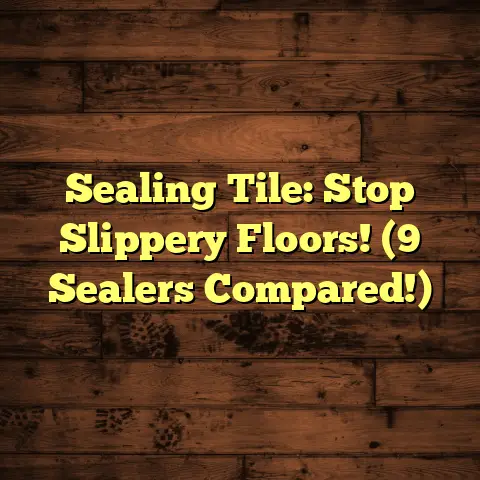Remove Subfloor Moisture? (1 Drying Mistake!)
Subfloor moisture is a silent killer of flooring, and it’s something we need to tackle head-on.
Now, before we dive deep, let’s set the stage.
Imagine spending a fortune on beautiful hardwood floors,
only to watch them warp and buckle within a year.
Or
worse, imagine your family breathing in mold spores
because of hidden moisture.
That’s why understanding and addressing subfloor moisture
is absolutely crucial for the longevity of your flooring
and the health of your home.
And guess what?
Climate plays
a HUGE role in all of this.
Whether you’re baking in the Arizona sun, battling humidity in Florida, or braving the cold in Minnesota, your climate directly impacts how your subfloor behaves.
Let’s get started!
1. Understanding Subfloor Moisture
So, what exactly is subfloor moisture?
Simply put, it’s the presence of unwanted water or dampness
in the material that forms the foundation of your flooring.
This subfloor is usually made of plywood or OSB (oriented
strand board).
Think of it as the unsung hero beneath
your beautiful floors.
Now, where does this moisture come from?
Well, there are a few common culprits:
Leaks: These can be from plumbing issues, roof
damage, or even leaky appliances.
I once dealt with a
case where a tiny pinhole leak in a washing machine
hose caused major subfloor damage over several months.
Crazy, right?Condensation: This happens when warm, moist air
meets a cold surface.
Think of a cold glass of water
on a hot day.
The same thing can happen under your
floors, especially in areas with poor ventilation.Groundwater Intrusion: This is more common in
basements or homes with inadequate drainage.
Water can
seep up through the foundation and into the subfloor.
Okay, so moisture is there. Big deal, right?
Wrong! Subfloor moisture can lead to a whole host of problems, including:
Mold Growth: This is a big one.
Mold loves moisture,
and it can spread rapidly in a damp subfloor.
Not only
is mold unsightly, but it can also cause serious health
problems, especially for people with allergies or asthma.-
Structural Damage: Over time, moisture can weaken
the subfloor, causing it to rot, warp, or even collapse.
I’ve seen floors that literally bounced when you walked
on them because the subfloor was so damaged. Compromised Flooring Materials: Moisture can ruin
just about any type of flooring.
Hardwood can warp and
cup, laminate can bubble and peel, and even tile can
crack if the subfloor is unstable.
2. The Role of Climate in Subfloor Moisture
Now, let’s talk about climate.
As I mentioned earlier,
where you live has a HUGE impact on your risk of subfloor
moisture problems.
Humid Climates: If you live in a humid area like
the Gulf Coast, you’re constantly battling moisture in
the air.
This can lead to condensation on cold surfaces,
especially in basements or crawl spaces.
According to
the EPA, indoor humidity levels should be between 30-50%
to prevent mold growth.
I’ve worked on jobs where the
humidity under the house was over 80%!Colder Climates: In colder regions, thermal bridging
can be a major issue.
This is when cold from the outside
travels through the building materials to the inside,
creating cold spots.
These cold spots attract moisture,
leading to condensation and potential mold growth.Arid Regions: You might think that arid regions
are immune to moisture problems, but that’s not the case.
Sudden rain events can overwhelm drainage systems and
lead to unexpected water infiltration.
Also, homes with
evaporative coolers can experience increased humidity
levels, which can contribute to subfloor moisture.
I remember working on a house in Phoenix, Arizona.
It was
the middle of the summer, and the humidity was surprisingly
high due to a monsoon storm.
The homeowner had left their
windows open, and the subfloor had absorbed a ton of moisture.
We had to bring in industrial dehumidifiers to dry it out
before we could install the new flooring.
3. Identifying Moisture Problems
Okay, so how do you know if you have a subfloor moisture problem?
Here are some signs to look for:
-
Discoloration: Look for water stains, dark spots, or
any other unusual discoloration on the subfloor. Mold Growth: This is the most obvious sign.
Mold can
be black, green, white, or even orange.
If you see mold,
don’t ignore it!-
Musty Smell: A persistent musty odor is a telltale
sign of moisture and mold. -
Warping or Buckling: If your flooring is warped or
buckling, it could be a sign that the subfloor is
absorbing moisture. Soft Spots: Press down on the subfloor in different
areas.
If you feel any soft spots, it means the wood is
rotting.
Now, the best way to confirm your suspicions is with moisture testing.
Here are a couple of tools you can use:
Moisture Meter: This is a handheld device that measures
the moisture content of wood and other materials.
There are
two types of moisture meters: pin meters and pinless meters.
Pin meters insert small pins into the wood to measure the
moisture content, while pinless meters use electromagnetic
waves to measure the moisture content without damaging the
wood.
I prefer pinless meters because they don’t leave
holes in the subfloor.Hygrometer: This device measures the relative humidity
of the air.
You can use a hygrometer to check the humidity
levels under your house or in your basement.
According to the National Wood Flooring Association (NWFA),
the ideal moisture content for wood flooring is between 6-9%.
If your subfloor moisture content is significantly higher than
that, you have a problem.
4. The Drying Process
So, you’ve identified a subfloor moisture problem. Now what?
Well, the first step is to dry out the subfloor.
Here are
some conventional methods:
Natural Ventilation: Open windows and doors to allow
fresh air to circulate.
This is a simple and effective
method, but it’s not always practical, especially in
humid climates.Dehumidifiers: These devices remove moisture from the
air.
They’re especially useful in basements or crawl spaces.
I recommend using a dehumidifier with a built-in pump so
you don’t have to empty it manually.Heat Sources: Fans and heaters can help to speed up the
drying process.
However, be careful not to overheat the
subfloor, as this can cause it to crack or warp.
Now, here’s the thing: drying time can vary greatly depending on climate conditions and flooring materials.
In humid climates, it can take weeks or even months to dry out
a subfloor completely.
In drier climates, it might only take
a few days.
Also, thicker subfloors will take longer to dry
than thinner ones.
5. The One Common Drying Mistake
Alright, folks, this is the part you’ve been waiting for.
I’m about to reveal the single most common mistake people
make when trying to dry out a subfloor.
Are you ready?
Here it is:
Sealing the Subfloor Too Soon!
That’s right!
I see this all the time.
People get so eager
to finish their flooring project that they seal the subfloor
before it’s completely dry.
Why is this a problem?
Well, when you seal a damp subfloor, you’re trapping moisture
inside.
This creates a perfect breeding ground for mold and
rot.
It’s like putting a lid on a pot of stew – the moisture
has nowhere to go.
I know, I know, it’s tempting to seal the subfloor to protect
it from future moisture.
But trust me, you’re doing more harm
than good.
I remember a homeowner in Austin, Texas, who installed new
laminate flooring over a slightly damp subfloor.
He figured
the laminate would protect the subfloor from moisture.
Big mistake!
Within a few months, the laminate started to bubble and peel.
When I pulled it up, I found a thick layer of mold growing
underneath.
The homeowner had to rip out the entire floor
and replace the subfloor.
Why does this mistake happen so often?
Well, there are a few reasons:
-
Misconceptions: People often think that sealing the
subfloor will prevent moisture problems, when in reality,
it can exacerbate them. -
Impatience: Homeowners are often eager to finish their
flooring project and don’t want to wait for the subfloor
to dry completely. -
Lack of Knowledge: Many people simply don’t realize
how important it is to dry out the subfloor before sealing it.
6. Correcting the Mistake
Okay, so you’ve made the mistake of sealing a damp subfloor.
Don’t panic!
Here’s what you need to do:
Remove the Flooring: This is the first and most
important step.
You need to remove the flooring so you
can access the subfloor.-
Assess the Damage: Once you’ve removed the flooring,
inspect the subfloor for mold, rot, and other damage. -
Dry Out the Subfloor: Use the methods I mentioned
earlier – natural ventilation, dehumidifiers, and heat
sources – to dry out the subfloor completely. Test the Moisture Content: Use a moisture meter to
check the moisture content of the subfloor.
Make sure it’s
within the recommended range (6-9% for wood).Address Any Mold or Rot: If you find mold or rot, you’ll
need to treat it with a fungicide or wood preservative.
In
severe cases, you may need to replace the affected areas of
the subfloor.Seal the Subfloor (Properly): Once the subfloor is
completely dry and free of mold and rot, you can seal it
with a vapor barrier or waterproofing membrane.
This will
help to protect it from future moisture problems.
Now, here are some tips for drying out a subfloor in different climate conditions:
Humid Climates: In humid climates, ventilation is key.
Open windows and doors to allow fresh air to circulate.
You can also use fans to improve airflow.
Additionally,
consider using a dehumidifier to remove moisture from the air.Dry Climates: In dry climates, you can use heat to speed
up the drying process.
However, be careful not to overheat
the subfloor, as this can cause it to crack or warp.
I
recommend using a space heater on a low setting and
monitoring the temperature closely.
7. Long-term Solutions and Prevention
Okay, so you’ve dried out your subfloor and sealed it properly.
Now, how do you prevent future moisture problems?
Here are some long-term solutions and preventative measures:
Proper Grading: Make sure the ground around your house
slopes away from the foundation.
This will help to prevent
water from pooling around your foundation and seeping into
your subfloor.Drainage Systems: Install gutters and downspouts to
channel rainwater away from your house.
You can also install
a French drain to collect groundwater and divert it away
from your foundation.Vapor Barriers: Install a vapor barrier under your house
to prevent moisture from rising up from the ground.
This is
especially important in crawl spaces.Regular Maintenance Checks: Inspect your subfloor regularly
for signs of moisture damage.
Look for water stains, mold,
and soft spots.Moisture Monitoring: Use a hygrometer to monitor the
humidity levels under your house.
If the humidity levels are
consistently high, you may need to take additional steps
to reduce moisture.
I recommend checking your subfloor at least twice a year – once
in the spring and once in the fall.
This will give you a chance
to catch any problems early before they become serious.
I once worked with a homeowner who had a chronic subfloor
moisture problem.
They had tried everything to fix it, but
nothing seemed to work.
Finally, I suggested that they install
a sump pump in their basement.
The sump pump automatically
pumps out any water that accumulates in the basement, which
helped to keep the subfloor dry.
Statistics Time!
According to the American Society of Home Inspectors (ASHI),
about 60% of homes have some form of moisture problem in the
basement or crawl space.
That’s a pretty staggering number!
Conclusion
Alright, folks, that’s it!
We’ve covered everything you need
to know about subfloor moisture, including how to identify it,
how to dry it out, and how to prevent it from coming back.
Remember, subfloor moisture is a serious issue that can lead to a whole host of problems, including mold growth, structural damage, and compromised flooring materials.
But don’t worry!
By following the tips and advice I’ve shared
in this article, you can protect your home and your flooring
investment.
And remember the one common drying mistake: Don’t seal the subfloor too soon! Make sure it’s completely dry before you seal it.
Now, I want to hear from you!
Have you ever dealt with subfloor
moisture problems?
What did you do to fix them?
Share your
experiences in the comments below!
And as always, if you have any questions, don’t hesitate to ask.
I’m here to help!





